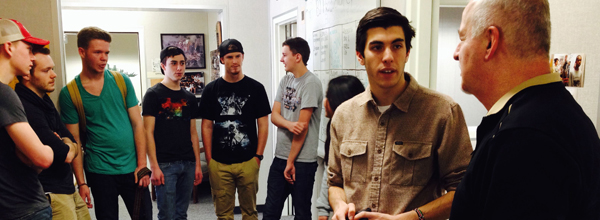Putting the “Journalism” Back in Broadcast Journalism

There’s no doubt in my mind that broadcast is the redheaded stepchild of the journalism world. And it’s mostly our own fault. Somehow we’ve strayed from the legendary journalism of Edward R. Murrow and Walter Cronkite. We teach our students to emulate professionals, but more and more, these “pros” bow to market forces and aim to please the lowest common denominator.
Just like the wrestling coach at your school doesn’t use the WWF as a model for good technique, and the newspaper adviser doesn’t use The National Enquirer as an example of newswriting, neither should we rely on local TV or cable news networks as the gold standard of broadcast journalism. While it’s important to understand the conventions of professional broadcasters, we owe it to our students–and society–to aim higher and do better.
It’s time for all of us to recalibrate our classrooms to emphasize the why of broadcast journalism, not just the how.
Admittedly, this isn’t an easy thing to do. Most of us are not trained as journalists, and fewer are trained on videography, editing systems and maintaining a broadcast facility. If we put half as much time and energy working on our journalism curriculum as we have on equipment, we’d be much farther ahead in our goal of training the next generation of news directors and producers.
Here are some suggestions for how to improve our curriculum and put the “journalism” back in broadcast journalism.
- Advisers need to make an effort to educate themselves on journalism law and ethics. Begin with the Student Press Law Center, which has tons of free legal briefs (copyright, fair use, freedom of information act, privacy rights, etc.) and even provides free legal counsel for staffs and advisers.
- Take stock of your coverage. What’s the ratio of feature stories (about people, culture, victims of tragedy and other ‘soft news’) compared to ‘hard’ news stories (those about difficult, controversial or hard-hitting topics)? Ask yourself and your staff why you have that ratio and if you might do well to add some more hard news stories to the mix. Adjust your ratio accordingly to suit your needs and curricular goals.
- Reset expectations. Speak with your principal, your staff and colleagues so they understand your curricular goals of teaching journalism, not just career and technical job skills (journalism can be a job, too!).
- Call your class what it is. Are you teaching a broadly-defined “media technology” exploratory elective class? Then clearly delineate your units on journalism from film production, animation and graphics. If you can, have an entirely separate class for broadcast journalism so students don’t confuse journalism with narrative (and subjective) storytelling.
- Seek advice from knowledgeable colleagues. Start with your school’s journalism advisers, and develop your journalism personal learning network (PLN). Twitter, Facebook, Google+ and list serves are a great way to meet other journalism advisers and get ideas for curriculum and solutions to the challenges we face as advisers.
- Become active in journalism organizations like JEA and NSPA that put the emphasis squarely on journalism. We still need our techie networks, but branch out and learn from folks who have been teaching journalism for years. I’ve personally learned the most from print journalism advisers. Check out these resources and lesson plans for journalism teachers.
- Attend journalism conventions (not just “film” or “television” conventions). Your students will be surrounded by other ambitious journalism students and you’ll meet many advisers whose singular focus is on reporting news. News is news–the only difference is how we deliver that information.
- Show examples of nationally award-winning work. NSPA and the Academy of Scholastic Broadcasting post the top stories from their contests.
- Look to other news publications for ideas about coverage and story topics. Read and review national newspapers like the New York Times and Washington Post, and online news publications like Politico and Pro Publica.

While we often worry about “entertaining” our audience with feature stories and humor, my experience is that the highest viewership and most talked about stories are those that we produced about controversial topics, or dealt with difficult subject matter. Students and staff truly care about what’s REALLY going on in the world, and rely on us to set the rumors straight. There is still plenty of room for creative, fun stories in your coverage.
Take your time. Ease into your news coverage with one or two stories at a time. Find your best staff members who are willing to tackle serious subject matter and encourage them throughout the process. Assess the feedback and results after the stories air.
This is the one chance for our students to be journalists relatively free from the pressures of advertising and corporate profit. Let’s take advantage of the opportunity to help them develop their journalistic voice and improve the community. Find out more about how to put the “journalism” back into broadcast journalism by visiting our Guide to Broadcast and Video.





